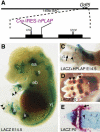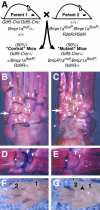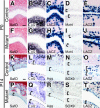BMP receptor signaling is required for postnatal maintenance of articular cartilage
- PMID: 15492776
- PMCID: PMC523229
- DOI: 10.1371/journal.pbio.0020355
BMP receptor signaling is required for postnatal maintenance of articular cartilage
Abstract
Articular cartilage plays an essential role in health and mobility, but is frequently damaged or lost in millions of people that develop arthritis. The molecular mechanisms that create and maintain this thin layer of cartilage that covers the surface of bones in joint regions are poorly understood, in part because tools to manipulate gene expression specifically in this tissue have not been available. Here we use regulatory information from the mouse Gdf5 gene (a bone morphogenetic protein [BMP] family member) to develop new mouse lines that can be used to either activate or inactivate genes specifically in developing joints. Expression of Cre recombinase from Gdf5 bacterial artificial chromosome clones leads to specific activation or inactivation of floxed target genes in developing joints, including early joint interzones, adult articular cartilage, and the joint capsule. We have used this system to test the role of BMP receptor signaling in joint development. Mice with null mutations in Bmpr1a are known to die early in embryogenesis with multiple defects. However, combining a floxed Bmpr1a allele with the Gdf5-Cre driver bypasses this embryonic lethality, and leads to birth and postnatal development of mice missing the Bmpr1a gene in articular regions. Most joints in the body form normally in the absence of Bmpr1a receptor function. However, articular cartilage within the joints gradually wears away in receptor-deficient mice after birth in a process resembling human osteoarthritis. Gdf5-Cre mice provide a general system that can be used to test the role of genes in articular regions. BMP receptor signaling is required not only for early development and creation of multiple tissues, but also for ongoing maintenance of articular cartilage after birth. Genetic variation in the strength of BMP receptor signaling may be an important risk factor in human osteoarthritis, and treatments that mimic or augment BMP receptor signaling should be investigated as a possible therapeutic strategy for maintaining the health of joint linings.
Conflict of interest statement
The authors have declared that no conflicts of interest exist.
Figures







References
-
- Ahn K, Mishina Y, Hanks MC, Behringer RR, Crenshaw EB, 3rd. BMPR-IA signaling is required for the formation of the apical ectodermal ridge and dorsal-ventral patterning of the limb. Development. 2001;128:4449–4461. - PubMed
-
- Apte SS, Seldin MF, Hayashi M, Olsen BR. Cloning of the human and mouse type X collagen genes and mapping of the mouse type X collagen gene to chromosome 10. Eur J Biochem. 1992;206:217–224. - PubMed
-
- Badley EM. The effect of osteoarthritis on disability and health care use in Canada. J Rheumatol Suppl. 1995;43:19–22. - PubMed
-
- Bau BH, Haag J, Schmid E, Kaiser M, Gebhard PM, Aigner T. Bone morphogenetic protein-mediating receptor-associated Smads as well as common Smad are expressed in human articular chondrocytes but not up-regulated or down-regulated in osteoarthritic cartilage. J Bone Miner Res. 2002;17:2141–2150. - PubMed
-
- Baur ST, Mai JJ, Dymecki SM. Combinatorial signaling through BMP receptor IB and GDF5: Shaping of the distal mouse limb and the genetics of distal limb diversity. Development. 2000;127:605–619. - PubMed
Publication types
MeSH terms
Substances
Associated data
- Actions
- Actions
LinkOut - more resources
Full Text Sources
Other Literature Sources
Molecular Biology Databases
Research Materials

